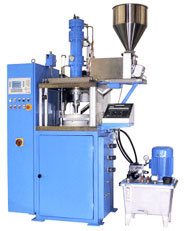Ram Extruder
Introduction
A ram extruder is an extruder where, instead of extrusion screw, a ram or plunger is used . The ram extruder was the earliest extruder to be used in the plastics industry. This typical process is applied for producing profiles, sleeves, rod, block, tubing, lining sheet bars, etc. The ram extrusion process is very effective for specific materials like PTFE which are not extruded successfully using screw extruder.

Process
In this process plastic material in powder form is gravity fed into a chamber. In the extrudating chamber the resin powder is heated on sintering temperature. Ultra high molecular weight polyethylene, becomes gelatinous as it melts so it can be extruded with this type of processes. A hydraulic ram pushes the resin materials like PTFE, UHMW, etc. from the chamber to the die. The die actually gives the shape of the desired plastic like a rod, tube or a profile shape with the requisite internal or outer diameter. When the material comes out of the die, it moves the length of the conveyor. The profiles can be manufactured endlessly and cut by the continuous extruding of each length.
Types of Machines
There are two types of ram extrusions- the vertical ram extrusion and the horizontal ram extrusion. Whatever be the type of ram extrusion, the resin feed, compaction or performing, sintering and cooling are all the same. But the extrudates quality depends on various parameter like the design of the extruder, powder properties, extrusion rate, pressure and temperature.
Nowadays, high quality mechanically engineered extrusion machines are available in the market that are highly innovative in its application. Fully automated systems are also available. Advanced range of machines ensures precision both in the pressing procedure and in the sinter zone. By adjusting the pressure and speed of the ram extruder every individual profile can be extruded perfectly. Also, temperature controls are also provided. |
|